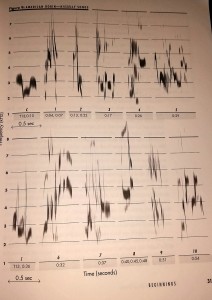American Robins (Turdus migratorious) belong to the suborder oscines, a large suborder of passerine birds that encompasses most songbirds. They are open-ended song learners: they continue to learn new songs throughout their lives. Nestlings first acquire calls which they use to beg for food from their parents. The begging calls are quiet simple and tend to get louder as the nestlings grow. Young males primarily learn their songs from neighboring male tutors but they also invent their own songs. They continue to invent new songs well after they establish their own territories. The young males tend to learn the song elements they hear on a regular basis (Johnson, 2006).
Males usually start singing in late winter or early spring. During this time, they sing for several minutes without any pauses. Their song, often described as a “clear caroling cheerily, cheer up, cheer up, cheerily, cheer up“, is made up of multiple syllables. To the untrained ear, the song sounds like a series of whistles, rising and falling in pitch.
They also have another song known as a “hisselly-hisselly.” This is a whisper song usually sang at dawn and dusk, sometimes followed by a variable “cheerily, cheer up, cheer up, cheerily, cheer up.” In mated males, singing behavior is influenced by the female’s roosting behavior: a male sing less when the female leaves her night roost (Slagsvold, 2006).
Both males and females produce calls and notes in response to looming danger. The most common notes are the “chirr” and the “chirp, chuck, cuck, or yeep.”
In areas where there is a high level of artificial light such as urban areas, American Robins begin singing their dawn chorus much earlier (Miller, 2006). Also, in areas where there is a high level of noise pollution, they tend to sing at a much higher frequency (Fullam et al., 2011). Precipitation and temperature also affect their singing behavior: they begin singing their dawn chorus much earlier in colder weather and in the absence of precipitation (Bruni et al., 2014).
Sonogram of the hisselly song

Sonogram of the cheerily, cheer up, cheer up, cheerily, cheer up song
Example call
Research is needed to ascertain the effects of human induced environmental changes on the migratory pattern of American Robins. This can be done by keeping track of a tagged population.
References:
1. http://bna.birds.cornell.edu/bna
2. Kroodsma, D. 2005. Beginnings In: Kroodsma, D. (eds) The Singing Life of Birds: The Art and Science of Listening to Birdsong. New York, New York, pp. 23-41.
2

what the advantage of this song?